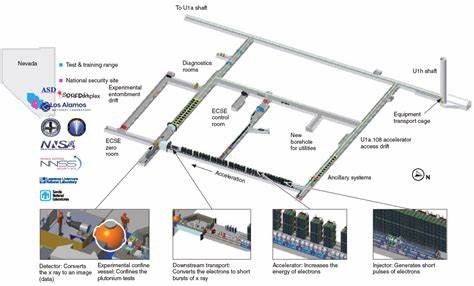Part 2 of 2 Parts (Please read Part 1 first)
One of the major questions that will be answered by Scorpius is how effective the plutonium in the U.S. nuclear stockpile may prove to be, given its age.
Custer said, “The newest systems we have first went into the stockpile in the 1980s. If you bought a car in 1992 and parked it in your garage, doing nothing to it, do you think it would start tomorrow on the first turn of the key? Not a perfect analogy, but you could do experiments and simulate things all you want, but you still want to turn the key and hear the engine turn over every once in a while, to know it will start when you need it.”
Custer goes on to say that we know that plutonium does undergo spontaneous fission. “This means that the material we first made and shaped precisely decades ago now has impurities from the fission in it, and the crystal structure has been damaged by the energetic decays. If you look at steel, very small changes to composition can make large changes to, for example, the mechanical strength. The X-ray images from Scorpius will help validate that at full scale, the plutonium still behaves as needed in spite of such changes.”
Scorpius is designed to generate high-energy pulses of electrons. It slams the electrons into a heavy metal target to create bright X-ray flashes that will capture pictures of the plutonium.
Custer said, “There are very good models of what happens inside a nuclear weapon. We will now be able to take detailed X-ray images of what happens as the device implodes to see if the models are right. If the models are not right, we will make them right. We can’t afford to be wrong.”
A key part of the Scorpius design is the manner in which it can generate huge pulses of electrical energy. Instead of relying on giant banks of capacitors for this task, it will use more than forty thousand commercial printed circuit boards to create four twenty-five-thousand volt pulses. These will energize a twenty-two million electron-volt electron beam.
Custer said, “The flexibility and programmability of the units makes it much easier to create precisely the X-ray bursts that the experimenters want for their particular experiment. Taking advantage of commercially available chips and standard electronics assembly similar to, for example, a desktop computer board, is just a good engineering choice. It also is likely that as commercial parts get more capable—higher voltages, higher currents—there are upgrade paths in the future for even higher performance of the machine if wanted.”
With the release this year of Christopher Nolan’s movie “Oppenheimer,” the public’s attention has turned once again to nuclear weapons. Custer said, “One of the scenes in the movie was several scientists betting whether the Trinity test would ignite the atmosphere, which was disturbing—an understatement—to General Groves. There was uncertainty there, although the possibility was swiftly debunked in real life. Scorpius aims to eliminate any uncertainty.”
Blog
-

Nuclear Weapons 835 – U.S. National Laboratories Are Building A Machine Called Scorpius To Help Improve Computer Models Of Nuclear Materials – Part 2 of 2 Parts
-
Nuclear News Roundup October 17, 2023
Poland’s Pomerania backs proposed nuclear plant location world-nuclear-news.org
Repair work under way at Krško nuclear power plant world-nuclear-news.org
EPRI, NEA in WISARD waste integration collaboration world-nuclear-news.org
CNSC renews licenses for Cameco uranium operations world-nuclear-news.org
-

Geiger Readings for October 17, 2023
Ambient office = 92 nanosieverts per hour
Ambient outside = 112 nanosieverts per hour
Soil exposed to rain water = 115 nanosieverts per hour
Strawberry tomato from Central Market = 93 nanosieverts per hour
Tap water = 97 nanosieverts per hour
Filter water = 86 nanosieverts per hour
-

Nuclear Weapons 834 – U.S. National Laboratories Are Building A Machine Called Scorpius To Help Improve Computer Models Of Nuclear Materials – Part 1 of 2 Parts
Part 1 of 2 Parts
Below the Nevada desert, a machine called Scorpius is being constructed that will utilize high explosives to crush plutonium to states that exist just before a nuclear explosion. The goal of the U.S. two-billion-dollar project is to scan this plutonium with X-rays to help check the accuracy of supercomputer models designed to predict whether the U.S. aging nuclear arsenal will work.
In the first fifty years of the U.S. nuclear weapons program, scientists tested whether the nuclear bombs worked by actually detonating them. In 1992, President George H.W. Bush signed into law a moratorium on nuclear tests.
Currently, supercomputer models are used to predict whether U.S. nuclear weapons might work. However, the accuracy of the models remains uncertain. Scientists do use data from actual explosives for these models. However, these surrogate materials possess significant differences from the plutonium typically used to make nuclear weapons. This raises the question of exactly how well these models simulate real nuclear explosions.
Jon Custer is a technical manager at Sandia National Laboratories in Albuquerque, New Mexico. He said, “Plutonium is a strange element, displaying six different crystal structures between room temperature and melting, at normal pressure, and a seventh phase at slightly elevated pressure. Three of these crystal structures are unique to plutonium. This means that there is no surrogate material that will truly mimic plutonium behavior.”
Nuclear bombs use high explosives to force weapons-grade plutonium or uranium-235 to implode. This triggers a catastrophic nuclear chain reaction. Scorpius is designed to create nanosecond-long X-ray images of plutonium as it compresses the plutonium or uranium with high explosives. Scorpius took its name from Scorpius X-1 which is the brightest extrasolar X-ray source. The name also reflects its subterranean location where desert scorpions burrow underground.
The goal of Scorpius is to help give supercomputer models the accurate data that they require to ascertain whether they are generating realistic simulation of nuclear-weapon behavior. The device is expected to be operational by late 2027. It is under construction a thousand feet beneath the Nevada National Security Site which is a test area bigger than the state of Rhode Island.
Jon Custer is the lead scientist for Scandia’s part of Scorpius. He said, “We will understand the performance and reliability of the nuclear stockpile, a critical part of our national security.” Scorpius is a joint project of the Sandia, Los Alamos, and Lawrence Livermore national laboratories, as well as the Nevada National Security Site.)
Scorpius is specifically designed to “tickle the dragon’s tail” according to Custer. The explosives are designed to bring plutonium to a highly compressed, hot state, but not beyond the critical point at which it would explode.
Custer said, “The conditions in an implosion, even before nuclear yield, are unfathomable to humans. Well before the device would go critical, the temperature inside is well above the surface of the sun, and the pressure is approaching that of the core of the sun. So while we think the models we use are really, really good across such huge changes, we need to test just how good they are. Scorpius allows us to image the real thing. While Scorpius will image late-time behavior, the subcritical experiments are not physically able to assemble into a critical configuration.” Custer also said that there is a long history of experiments bringing plutonium to “subcritical” conditions.
Please read Part 2 next -
Nuclear News Roundup October 16, 2023
2 workers at Fukushima plant hospitalized after accidentally getting sprayed with radioactive waste apnews.com
Westinghouse moving to Etna to develop transportable nuclear battery cbsnews.com
Russia says it thwarted a Ukrainian drone attack near its Kursk nuclear plant france24.com
Russian drone debris downed power lines near a Ukraine nuclear plant. A new winter barrage is likely apnews.com
-

Geiger Readings for October 16, 2023
Ambient office = 76 nanosieverts per hour
Ambient outside = 80 nanosieverts per hour
Soil exposed to rain water = 73 nanosieverts per hour
Mini cucumber from Central Market = 108 nanosieverts per hour
Tap water = 100 nanosieverts per hour
Filter water = 84 nanosieverts per hour
-
Nuclear News Roundup October 15, 2023
Blasts Damage Windows at Ukraine’s Khmelnytskyi Nuclear Plant usnews.com
Russia conducts military exercises after revocation of nuclear test ban treaty jurist.org
Turns Out We Came Closer Than We Knew to a Nuclear-Armed South Africa esquire.com
Russia Says It Has Rehearsed Nuclear Retaliation Strike themessenger.com
-

Geiger Readings for October 15, 2023
Ambient office = 93 nanosieverts per hour
Ambient outside = 113 nanosieverts per hour
Soil exposed to rain water = 111 nanosieverts per hour
Blueberryy from Central Market = 104 nanosieverts per hour
Tap water = 74 nanosieverts per hour
Filter water = 62 nanosieverts per hour
-
Nuclear News Roundup October 14, 2023
Ukraine brings in new pre-licensing assessment for nuclear projects world-nuclear-news.org
Westinghouse signs Bulgaria supplier MoUs world-nuclear-news.org
Nuclear future part of Illinois veto session thetelegraph.com
Fuel loading begins at Kakrapar 4 world-nuclear-news.org
-

Geiger Readings for October 14, 2023
Ambient office = 81 nanosieverts per hour
Ambient outside = 87 nanosieverts per hour
Soil exposed to rain water = 90 nanosieverts per hour
Avocado from Central Market = 93 nanosieverts per hour
Tap water = 88 nanosieverts per hour
Filter water = 74 nanosieverts per hour
Dover Sole from Central = 99 nanosieverts per hour
